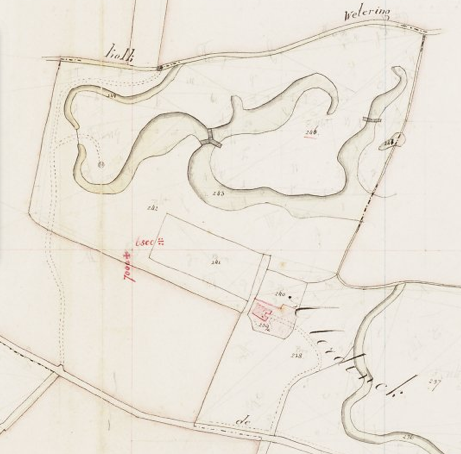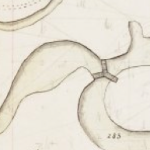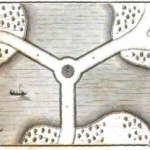Not necessarily as a result of my previous post about the Triple Bridges map, a new addition to the map is made public in this post. Above that we take a look at different typologies of these bridges that seem to present themselves, with the preliminary conclusion that these differences seem to be regionally determined.
Bridge at Den Alerdinck, circa 1800
This weekend I was talking to dr Lucia Albers, who mentioned to me that there was a triple bridge at Den Alerdinck, a garden to the south east of Zwolle. Although the bridge itself is not mentioned there, her publication about the architect of the landscape garden at Den Alerdinck dates back exactly 20 years. 1Albers, dr. L.H., ‘Wie was de architekt van De Alerdink bij Heino’, in Cascade 2 (1993), nr.2, pages 13-18.
Den Alerdinck, detail of the survey map of 1812-1822.
Source: watwaswaar.nl
The website of Den Alerdinck mentions Johan David Zocher (1763-1817) as the designer of the landscape garden. 2A design of this garden does not exist. Albers noted that this name is indeed mentioned in the family that owned the estate for a long time, but she has her doubts. She presented several other possible architects for this garden, notably G.A. Blum(e) (1765-1827). Both Zocher and Blum(e) are also named as the architects that drew a map of Fraeylemaborg, possibly as early as 1802. There is also a triple bridge in that garden. They were of the same generation, both of German descent, and it seems it is not easy to distinguish between the two (even when drawings exist).
Albers managed to reduce the design period of this landscape garden at Den Alerdinck to 1797-1807, regardless of who the architect was. This fits quite well in with what we think we know about Blum(e), who worked in this part of the Netherlands more often. 3A report by Bureau N0.0rdpeil about Fraeylemaborg apperently already mentioned the fact that those owners had ties with the elite in Zwolle (see this comment by Jan Holwerda). Den Alerdinck’s owner Bernardus J. van Sonsbeeck belonged to this Zwolle elite, as did other estate owners who employed Blum(e). But Zocher worked throughout the whole country, so he cannot be ruled out.
Different types
While the triple bridge portfolio is building up, it becomes clear there are at least two different types. The bridges found in the Netherlands are all of the more simple type: three bridges coming together in the center, with no specific building or design on this meeting of paths.
The more southern gardens – those represented in Le Rouge, but also the garden in Wetteren (Belgium) – have a more elaborate meeting point (image right). There it is not just a location where parts of the bridge meet, it is embellished with a circular structure. In the Belgian garden there is even a Chinese building created on top of the center of the bridge (this may have also been the case in the Le Rouge examples, but there we only have the view from above). This center seems to have been more a place to dwell in southern gardens, than a section to pass, as is the case in the Dutch types (image left).
It is way too soon to conclude anything about the origins and the different typologies of the Triple Bridge, but I did want to point out that the northern types are up till now consistently different than the southern ones. Whether that is just a regional thing, or a question of taste or education, remains to be seen.
Related articles
Footnotes
| ↑1 | Albers, dr. L.H., ‘Wie was de architekt van De Alerdink bij Heino’, in Cascade 2 (1993), nr.2, pages 13-18. |
|---|---|
| ↑2 | A design of this garden does not exist. |
| ↑3 | A report by Bureau N0.0rdpeil about Fraeylemaborg apperently already mentioned the fact that those owners had ties with the elite in Zwolle (see this comment by Jan Holwerda). Den Alerdinck’s owner Bernardus J. van Sonsbeeck belonged to this Zwolle elite, as did other estate owners who employed Blum(e). |








De linkjes naar mijn site in deze berichten werken inmiddels niet meer; de gegevens die ik had gevonden mbt de driepuntsbruggen heb ik samengevat en gepubliceerd in het CASCADE bulletin voor tuinhistorie, jaargang 2015, nummer 1.
Binnenkort zal je dit artikel ook digitaal kunnen lezen.
AD